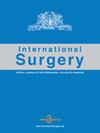胰腺创伤:管理算法的建议
IF 0.2
4区 医学
Q4 SURGERY
引用次数: 0
摘要
尽管近年来手术技术和保守治疗有所改进,但胰腺创伤仍具有潜在的致命性。然而,胰腺创伤的治疗尚无指南。在这篇报告中,我们根据我们的九个病例的经验和文献回顾,提出一个胰脏创伤的治疗算法。病例介绍:本研究包括9例胰腺外伤患者(5男4女)。患者中位年龄为40岁(范围17-75岁)。总死亡率为22.2%,术后死亡率为16.7%。两名患者有浅表创伤。1例患者存在深度创伤,但未损伤主胰管,该患者通过内镜下鼻胰引流成功治疗。2例患者出现活动性出血,经介入放射学控制。6例患者有深外伤伴主胰管损伤。其中1例患者经内镜鼻胰引流保守治疗后死亡。其他5例患者接受手术(胰腺切除术4例,坏死切除术1例)。结论该算法建议对活动性动脉出血采取介入放射治疗,对无导管损伤的创伤采取保守治疗,对有导管损伤的创伤采取手术治疗。该算法可为今后指导方针的制定提供依据。本文章由计算机程序翻译,如有差异,请以英文原文为准。
Pancreatic trauma: proposal for management algorithm
IntroductionPancreatic trauma is potentially lethal despite recent improvements in surgical techniques and conservative management. However, no guidelines for the management of pancreatic trauma have been established. In this report, we propose an algorithm for the management of pancreatic trauma based on our experience of nine cases and a literature review.Case presentationThis study included nine patients with pancreatic trauma (five men and four women). The patients’ median age was 40 years (range, 17–75 years). The overall mortality rate was 22.2%, and the postoperative mortality rate was 16.7%. Superficial trauma was present in two patients. Deep trauma without injury to the main pancreatic duct was present in one patient, and this patient was treated successfully with endoscopic nasopancreatic drainage. Active bleeding was present in two patients and controlled by interventional radiology. Deep trauma with injury to the main pancreatic duct was present in six patients. Among them, one patient died after conservative treatment with endoscopic nasopancreatic drainage. The other five patients underwent surgery (pancreatic resection in four and necrosectomy in one).ConclusionThe herein-described algorithm recommends interventional radiology for active arterial bleeding, conservative management for trauma without ductal injury, and surgery for trauma with ductal injury. This algorithm may provide a basis for future establishment of guidelines.
求助全文
通过发布文献求助,成功后即可免费获取论文全文。
去求助
来源期刊

International surgery
医学-外科
CiteScore
0.30
自引率
0.00%
发文量
10
审稿时长
6-12 weeks
期刊介绍:
International Surgery is the Official Journal of the International College of Surgeons. International Surgery has been published since 1938 and has an important position in the global scientific and medical publishing field.
The Journal publishes only open access manuscripts. Advantages and benefits of open access publishing in International Surgery include:
-worldwide internet transmission
-prompt peer reviews
-timely publishing following peer review approved manuscripts
-even more timely worldwide transmissions of unedited peer review approved manuscripts (“online first”) prior to having copy edited manuscripts formally published.
Non-approved peer reviewed manuscript authors have the opportunity to update and improve manuscripts prior to again submitting for peer review.
 求助内容:
求助内容: 应助结果提醒方式:
应助结果提醒方式:


